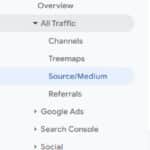Imagine, if you will, a classic sunset – one of those big, fiery ones that paint the sky in a thousand shades of orange, red, and purple. Now, think of Universal Analytics (UA) as that sun setting on July 1st, 2024, making way for Google Analytics 4 (GA4).
All those bright colors are your data, and you won’t see those exact same shades again—unless you take pictures.
The move to GA4 move isn’t just an update; it’s a complete system overhaul designed for a more privacy-focused, machine learning-powered future. This change might seem daunting, but it also presents a unique opportunity for businesses to revamp their data strategy for greater success.
Preserve Past Data to Create Future Success
Historical data is essential for forecasting, strategizing, and navigating…basically everything. It’s your staffing firm’s compass in the rapidly evolving digital marketing world. With UA going offline, access to this valuable compass will be lost unless you take action now.
Advice from Our SEO and PPC Experts
Google Analytics has a LOT of data. It’s doubtful you need to archive ALL of it. What (and how much) data your firm needs depends on how it makes decisions. How can you ensure the time, effort, and resources you put into archiving data pays off in the future?
Here’s what our SEO and PPC experts think you should focus on to ensure a smooth transition:
Overall Traffic Trends
Your firm likely experiences seasonal trends. Understanding these cyclical spikes and dips helps you anticipate demand and strategize accordingly.
When it comes to UA data preservation, our experts suggest looking at the start of traffic to the end of traffic to view the overall trend. If you see a spike, you can drill deeper to see what caused the traffic – and if it was good traffic.
Since you don’t want to be surprised next year when you don’t have the data to compare, think about what kind of information will help you make marketing decisions (and how to best dispay it in UA). Then export data that shows the trends that matter to your business.
For example, did you open a new location? Start an SEO strategy? Stop an SEO strategy?
Says Haley Marketing PPC expert Erin Helms, “Staffing firms might want to pull data to view the trends for each year. I personally think it’s overkill to download each month separately EACH year but that is certainly an option. Perhaps firms could consider saving the data from each month for 2018 or 2019 (pre-Covid) through 2023, as well as quarterly. The pandemic really shook things up for staffing and the data reflects that.”
(The image below shows the overall trend for three-year period: March 1st, 2020 through December 31st, 2023.)

Acquisition Sources
Knowing where your traffic comes from (social media, organic search, emails, etc.) is vital for optimizing your marketing efforts. Do you want to view the information by Channel? Or the more granular Source/Medium? Consider questions like these to help you decide what type of UA data to archive.
Behavior
Exporting data on your top-performing pages will provide insight into site visitors to guide content and UX improvements. Consider exporting your most popular 20 (or 100) pages.
Key Conversion Pages by Source
Knowing which pages have the highest conversion is critical for your business. Pay special attention to the following pages:
- Contact Us
- Service Pages
- Job/Applications
- About Us
Landing Pages
Understanding how clients and candidates find your firm can help you enhance user experience and conversion. We recommend analyzing the top 20 landing pages by traffic source.
Strategies for UA Data Preservation
How your firm archives UA data depends on its size, resources, and budget. Working from small- to large-scale solutions, consider the following options:
- Create PDF reports. After identifying the data you need, generate customs reports with your desired reporting ranges and periods and export them as PDFs from within UA.
- Export data as CVS or Google Sheets. Smaller firms may choose to create the report in the UI and export to Sheets or CSV from there. The export has a limitation of 5000 rows, so this works best for limited data. Google recommends using their Google Analytics Spreadsheet add-on to archive UA data. (On a larger scale, Looker Studio utilizes Google API for extracting data, eliminating row limits.)
- Pro Tip! In the bottom, right-hand corner of your UA screen, make sure the view contains all of the data rows you wish to capture or it WILL NOT EXPORT the rows. Expand as needed to capture the data you want to save.

- Pro Tip! In the bottom, right-hand corner of your UA screen, make sure the view contains all of the data rows you wish to capture or it WILL NOT EXPORT the rows. Expand as needed to capture the data you want to save.
- Look to The Cloud. For those comfortable working with APIs, a cloud-based storage solution might be the right solution. Google, Amazon, and Microsoft offer products to help preserve data.
- Use your custom database. Large firms may have an existing custom database and the expertise required to integrate marketing analytics data with CRM and ERP data.
DON’T LET THE SUN GO DOWN ON YOUR DATA!
Viewing the end of Universal Analytics as an opportunity, rather than a setback, can transform your firm’s approach to this transition. What better time to audit your data collection and analysis practices, ensuring they align with your business objectives?
Explore Our Digital Marketing Bundles
Haley Marketing has helped staffing companies make a bigger impact with their marketing efforts for more than 27 years. Whether you’re looking to sell more, fill more open orders, or increase your visibility in the marketplace, we’re here to guide you to success. Check out our Digital Marketing Bundles to get started TODAY!















